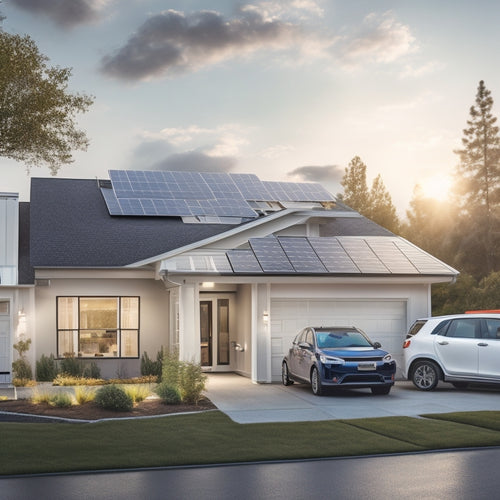
Designing Off-Grid Energy Storage Systems Made Easy
Share
You're designing off-grid energy storage systems to provide reliable power while minimizing waste and maintenance costs, and you need a streamlined approach to get it right. Start by selecting the right software tools that offer a user-friendly interface, data analytics, and cloud connectivity. Follow key design principles like load prioritization and system scalability to guarantee essential appliances remain operational. Simplify system sizing and configuration using automated tools, and optimize system performance with energy storage system simulation. Now, take the first step towards efficient off-grid energy storage system design, and discover more ways to refine your approach.
Key Takeaways
• Automated system layout generation and input load forecasting simplify the off-grid energy storage system design process.
• Data analytics and real-time monitoring enable optimized system performance and reduced energy waste.
• Cloud connectivity and remote access facilitate easy system management and troubleshooting.
• Simulation tools and virtual system replicas aid in identifying performance metrics and refining system design.
• User-friendly interfaces and automated reporting streamline the design process, making it more accessible and efficient.
Selecting the Right Software Tools
When designing an off-grid energy storage system, you need to select software tools that can accurately model and analyze your system's performance, ensuring that you can optimize energy storage and reduce costs.
The right software tools will enable you to simulate your system's behavior, identify potential issues, and make data-driven decisions.
To achieve this, you should look for software capabilities that include advanced simulation models, real-time data analytics, and customizable reporting. These features will allow you to gain a deeper understanding of your system's performance and identify areas for improvement.
Additionally, consider the user experience when selecting software tools. An intuitive interface and easy-to-use design will save you time and reduce the likelihood of errors.
Off-Grid Energy System Design Principles
With your software tools in place, you can now focus on designing an off-grid energy system that meets your specific needs and optimizes performance.
A well-designed system guarantees reliable power supply, reduces energy waste, and minimizes maintenance costs. To achieve this, you'll need to take into account key design principles.
Load prioritization is vital, as it allows you to allocate power to critical loads during periods of low energy availability. This ensures that essential appliances, such as refrigeration or medical equipment, remain operational even when energy is scarce.
Next, think about system scalability, which enables your system to adapt to changing energy demands or future upgrades. A scalable system allows you to add or remove components as needed, ensuring your energy needs are always met.
Key Features of Design Software
You'll want to look for design software that offers a range of key features to streamline your off-grid energy system design process and guarantee accurate results. A user-friendly interface is essential, allowing you to easily navigate through the design process and access critical system data.
Data analytics capabilities are also essential, providing you with valuable insights into system performance and optimization opportunities. Cloud connectivity is another important feature, enabling you to access and share system data remotely.
Real-time monitoring is also a must-have, allowing you to track system performance in real-time and respond to any issues promptly. Finally, automated reporting capabilities can save you time and effort by generating detailed system reports at the click of a button.
Simplifying System Sizing and Configuration
Your design software should be able to simplify system sizing and configuration by automatically generating ideal system layouts based on your specific energy requirements and available space. This means you can input your load forecasting data and the software will suggest the best battery capacity and configuration to meet your energy needs.
No more tedious calculations or manual adjustments - the software does the work for you.
With automated system sizing, you can quickly experiment with different scenarios and 'what-if' scenarios to find the most efficient and cost-effective solution. The software should also allow you to easily adjust parameters such as battery type, depth of discharge, and charge/discharge rates to fine-tune your system's performance.
Energy Storage System Simulation
As you explore energy storage system simulation, you'll need to select the right system modeling tools to accurately represent your off-grid energy storage system. These tools will enable you to create a digital replica of your system, allowing you to test and analyze its performance under various scenarios.
System Modeling Tools
Modeling energy storage systems using simulation tools enables designers to test and optimize system performance, ensuring efficient and reliable operation of off-grid energy storage systems.
As you design your off-grid energy storage system, you'll want to utilize system modeling tools to streamline the process. These tools allow you to create a virtual replica of your system, simulating real-world conditions and testing various scenarios. This enables you to identify potential issues and optimize your system's performance before deploying it in the field.
When selecting a system modeling tool, consider one that offers data visualization capabilities, allowing you to easily interpret complex data and make informed decisions. Additionally, look for tools that leverage cloud computing, providing scalable and on-demand computing resources. This enables you to run complex simulations quickly and efficiently, even with limited local computing resources.
Simulation Analysis Results
By analyzing simulation results, you can identify key performance indicators for your off-grid energy storage system, such as round-trip efficiency, depth of discharge, and charging cycles, to refine your design and optimize its operation. These metrics provide valuable insights into your system's performance, helping you make data-driven decisions to improve its overall efficiency.
Data visualization plays an essential role in simulation analysis, enabling you to quickly grasp complex performance metrics. By visualizing your data, you can identify trends, patterns, and correlations that might be difficult to discern from raw data. This facilitates a deeper understanding of your system's behavior, allowing you to pinpoint areas for improvement and optimize its performance.
Performance metrics, such as round-trip efficiency and depth of discharge, are critical in evaluating your system's effectiveness. By monitoring these metrics, you can identify opportunities to enhance your system's overall efficiency, reduce energy losses, and extend its lifespan.
Optimizing System Performance and Cost
As you design and deploy off-grid energy storage systems, you'll want to guarantee peak performance and cost-effectiveness.
To achieve this, you'll need to optimize energy efficiency and implement cost reduction strategies.
Energy Efficiency Optimization
You can greatly reduce the overall cost of ownership and enhance the performance of your off-grid energy storage system by implementing energy efficiency optimization strategies that minimize energy losses and maximize energy harvest. By conducting energy audits, you'll identify areas where energy is being wasted and pinpoint opportunities for improvement. This will enable you to optimize your system's performance, reduce your carbon footprint, and lower your energy bills.
To achieve peak energy efficiency, it's crucial to take into account every aspect of your off-grid energy storage system. This includes the type and quality of components, system design, and installation. By selecting high-efficiency components and designing a system that's tailored to your specific energy needs, you'll minimize energy losses and maximize energy harvest.
Additionally, implementing energy-efficient practices, such as adjusting your energy usage patterns and optimizing your load management, will further reduce your energy consumption and costs. By taking a comprehensive approach to energy efficiency optimization, you'll be able to create a reliable, cost-effective, and environmentally friendly off-grid energy storage system that meets your unique needs.
Cost Reduction Strategies
Optimizing system performance and cost is critical to reducing the overall cost of ownership for your off-grid energy storage system, and several strategies can help you achieve this goal. By implementing these strategies, you can minimize expenses and maximize the value of your investment.
Here are some cost reduction strategies worth exploring:
-
Material sourcing optimization: Identify alternative materials that can reduce costs without compromising system performance. This can include sourcing components from local suppliers or exploring alternative material options.
-
Streamlining supply chain operations: Analyze your supply chain to identify inefficiencies and areas for improvement. This can help reduce transportation costs, minimize inventory, and shorten lead times.
-
Design for manufacturability: Optimize your system design to simplify manufacturing and reduce production costs. This can include designing for modular components, reducing material waste, and minimizing assembly time.
- Energy efficiency optimization: Implement energy-efficient designs and components to reduce energy consumption and minimize waste heat generation. This can help reduce operating costs and extend system lifespan.
Integrating Renewable Energy Sources
Your off-grid energy storage system's capacity to integrate renewable energy sources, such as solar or wind power, is essential for minimizing reliance on fossil fuels and reducing carbon emissions.
By incorporating renewable infrastructure, you can create a sustainable energy ecosystem that's both environmentally friendly and cost-effective.
Energy hubs, which serve as central connection points for multiple renewable sources, can optimize energy distribution and reduce transmission losses.
Hybrid systems, combining different renewable sources, can guarantee a stable and reliable energy supply.
Effective power distribution is critical, and smart grids can play an essential role in managing energy flow, predicting energy demand, and optimizing energy storage.
By integrating these components, you can create a resilient and efficient off-grid energy system that meets your energy needs while minimizing your carbon footprint.
When designing your system, remember to take into account your specific energy requirements, local renewable resources, and infrastructure constraints to ensure a seamless integration of renewable energy sources.
Streamlining System Installation and Maintenance
Effective system design and planning are crucial to streamlining the installation and maintenance of your off-grid energy storage system, reducing downtime and minimizing costs. By doing so, you'll be able to identify potential issues before they become major problems, and guarantee that your system is running at peak efficiency.
To take your maintenance to the next level, consider the following:
-
On-site Training: Make sure that your team is equipped with the knowledge and skills to handle routine maintenance tasks, reducing the need for external support.
-
Preventive Maintenance: Regularly inspect and maintain your system to prevent unexpected failures and downtime.
-
Standardized Procedures: Establish clear, standardized procedures for maintenance tasks to ensure consistency and efficiency.
- Real-time Monitoring: Implement real-time monitoring systems to quickly identify and respond to any issues that may arise.
Frequently Asked Questions
How Do I Ensure Energy Storage System Safety and Compliance With Regulations?
"Imagine a solar-powered cabin in the woods, where a faulty energy storage system sparks a fire. To avoid this, you'll conduct a thorough Risk Assessment, ensuring Code Compliance with regulations like OSHA and NEC, to guarantee a safe and reliable energy storage system."
Can I Design an Off-Grid System for a Remote Community or Village?
You can design an off-grid system for a remote community or village by engaging with locals, understanding village dynamics, and involving them in the design process to guarantee a tailored, sustainable, and community-driven energy solution.
What Is the Ideal Battery Type for My Specific Off-Grid Application?
Did you know 70% of off-grid systems use batteries? When choosing yours, consider battery lifespan and depth discharge. For your specific application, a deep-cycle battery with a lifespan of 5-7 years and 50% depth discharge may be ideal for reliable energy storage.
How Do I Optimize Energy Storage for Seasonal or Periodic Energy Usage?
To optimize energy storage for seasonal or periodic energy usage, you'll want to contemplate load shaping and energy buffering strategies, ensuring your system adapts to fluctuating demands and stores excess energy for later use.
Can I Integrate Energy Storage With Existing Renewable Energy Infrastructure?
You're piecing together a renewable energy puzzle, and integrating energy storage is the final piece - seamlessly merging with your existing infrastructure like a hand in a glove, consider system upgrades and hybrid solutions to optimize your setup.
Related Posts
-

What Electric Vehicle Owners Need for Home Energy
As an electric vehicle owner, you need to optimize your home energy system to guarantee efficient, sustainable, and c...
-

Step-by-Step Guide to Converting Your Vehicle to EV
You'll begin by evaluating your vehicle's conversion potential, analyzing its weight, aerodynamics, and powertrain co...
-

Why Cities Need Smart Charging Infrastructure Now
You're about to experience a tidal wave of electric vehicles hitting your city's streets, and it's essential you're p...


